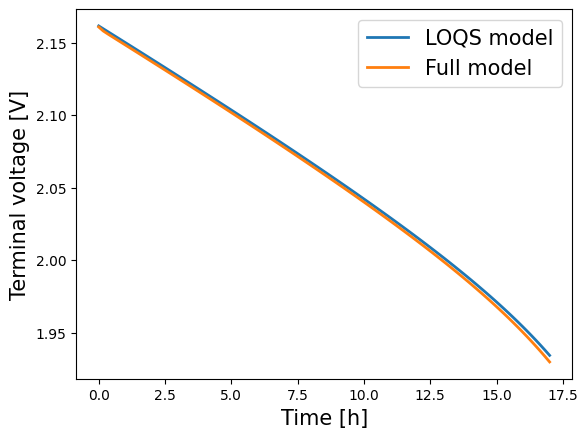Tip
An interactive online version of this notebook is available, which can be
accessed via
Alternatively, you may download this notebook and run it offline.
Attention
You are viewing this notebook on the latest version of the documentation, where these notebooks may not be compatible with the stable release of PyBaMM since they can contain features that are not yet released. We recommend viewing these notebooks from the stable version of the documentation. To install the latest version of PyBaMM that is compatible with the latest notebooks, build PyBaMM from source.
Lead-Acid Models#
We compare a standard porous-electrode model for lead-acid batteries with two asymptotic reductions. For a more in-depth introduction to PyBaMM models, see the SPM notebook. Further details on the models can be found in [4].
[1]:
%pip install "pybamm[plot,cite]" -q # install PyBaMM if it is not installed
import pybamm
import numpy as np
import os
import matplotlib.pyplot as plt
os.chdir(pybamm.__path__[0] + "/..")
WARNING: You are using pip version 22.0.4; however, version 22.3.1 is available.
You should consider upgrading via the '/home/mrobins/git/PyBaMM/env/bin/python -m pip install --upgrade pip' command.
Note: you may need to restart the kernel to use updated packages.
“Full” model#
Electrolyte Concentration#
Porosity#
Electrolyte Current#
Electrode Current#
Interfacial current density#
This model is implemented in PyBaMM as the Full model
[2]:
full = pybamm.lead_acid.Full()
“Leading-order” model#
This model is implemented in PyBaMM as LOQS (leading-order quasi-static)
[3]:
loqs = pybamm.lead_acid.LOQS()
Solving the models#
We load process parameters for each model, using the same set of (default) parameters for all. In anticipation of changing the current later, we make current an input parameter
[4]:
# load models
models = [loqs, full]
# process parameters
param = models[0].default_parameter_values
param["Current function [A]"] = "[input]"
for model in models:
param.process_model(model)
Then, we discretise the models, using the default settings
[5]:
for model in models:
# load and process default geometry
geometry = model.default_geometry
param.process_geometry(geometry)
# discretise using default settings
mesh = pybamm.Mesh(geometry, model.default_submesh_types, model.default_var_pts)
disc = pybamm.Discretisation(mesh, model.default_spatial_methods)
disc.process_model(model)
Finally, we solve each model using CasADi’s solver and a current of 1A
[6]:
timer = pybamm.Timer()
solutions = {}
t_eval = np.linspace(0, 3600 * 17, 100) # time in seconds
for model in models:
solver = pybamm.CasadiSolver()
timer.reset()
solution = solver.solve(model, t_eval, inputs={"Current function [A]": 1})
print(f"Solved the {model.name} in {timer.time()}")
solutions[model] = solution
Solved the LOQS model in 64.611 ms
Solved the Full model in 736.504 ms
Results#
To plot the results, the variables are extracted from the solutions dictionary. For example, we can compare the voltages:
[7]:
for model in models:
time = solutions[model]["Time [h]"].entries
voltage = solutions[model]["Voltage [V]"].entries
plt.plot(time, voltage, lw=2, label=model.name)
plt.xlabel("Time [h]", fontsize=15)
plt.ylabel("Voltage [V]", fontsize=15)
plt.legend(fontsize=15)
plt.show()

Alternatively, using QuickPlot, we can compare the values of some variables
[8]:
solution_values = [solutions[model] for model in models]
quick_plot = pybamm.QuickPlot(solution_values)
quick_plot.dynamic_plot();
If we update the current, setting it to be 20 A, we observe a greater discrepancy between the full model and the reduced-order models.
[9]:
t_eval = np.linspace(0, 3600, 100)
for model in models:
solver = pybamm.CasadiSolver()
solutions[model] = solver.solve(model, t_eval, inputs={"Current function [A]": 20})
# Plot
solution_values = [solutions[model] for model in models]
quick_plot = pybamm.QuickPlot(solution_values)
quick_plot.dynamic_plot();
At t = 0.0087774 and h = 1.94278e-62, the corrector convergence failed repeatedly or with |h| = hmin.
At t = 0.00384476 and h = 1.59607e-100, the corrector convergence failed repeatedly or with |h| = hmin.
References#
The relevant papers for this notebook are:
[10]:
pybamm.print_citations()
[1] Joel A. E. Andersson, Joris Gillis, Greg Horn, James B. Rawlings, and Moritz Diehl. CasADi – A software framework for nonlinear optimization and optimal control. Mathematical Programming Computation, 11(1):1–36, 2019. doi:10.1007/s12532-018-0139-4.
[2] Charles R. Harris, K. Jarrod Millman, Stéfan J. van der Walt, Ralf Gommers, Pauli Virtanen, David Cournapeau, Eric Wieser, Julian Taylor, Sebastian Berg, Nathaniel J. Smith, and others. Array programming with NumPy. Nature, 585(7825):357–362, 2020. doi:10.1038/s41586-020-2649-2.
[3] Valentin Sulzer, S. Jon Chapman, Colin P. Please, David A. Howey, and Charles W. Monroe. Faster Lead-Acid Battery Simulations from Porous-Electrode Theory: Part I. Physical Model. Journal of The Electrochemical Society, 166(12):A2363–A2371, 2019. doi:10.1149/2.0301910jes.
[4] Valentin Sulzer, S. Jon Chapman, Colin P. Please, David A. Howey, and Charles W. Monroe. Faster Lead-Acid Battery Simulations from Porous-Electrode Theory: Part II. Asymptotic Analysis. Journal of The Electrochemical Society, 166(12):A2372–A2382, 2019. doi:10.1149/2.0441908jes.
[5] Valentin Sulzer, Scott G. Marquis, Robert Timms, Martin Robinson, and S. Jon Chapman. Python Battery Mathematical Modelling (PyBaMM). Journal of Open Research Software, 9(1):14, 2021. doi:10.5334/jors.309.
